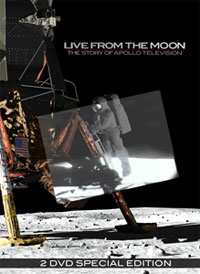|
|
Preview: Live from the Moon
by Jeff Foust
Monday, June 15, 2009
Live from the Moon: The Story of Apollo Television
Spacecraft Films, 2009
DVD and Blu-ray
If asked to describe NASA TV today in one word, most people in the space field would probably end up using variants of the term “boring”. While mission coverage can sometimes be compelling—last month’s spacewalks to repair the Hubble Space Telescope being one such example—routine (by comparison) work on the International Space Station, or other shuttle mission activities, don’t make for must see TV even for many diehard space aficionados. Forty years ago, though, was a different story, when NASA was rushing to the Moon and live television from space was in its infancy. The challenges of providing live television from orbit and the Moon, and the impact that coverage had, is the focus for a new documentary, Live from the Moon.
The documentary, produced by Spacecraft Films (scheduled for release later this summer; this review is based on a “rough cut” version distributed earlier this year that is essentially the same as the version to be released, according to the producers), in effect reviews the history of Apollo from a novel viewpoint: the effort to provide live television from the missions, particularly the lunar landings. That effort faced two distinct sets of challenges, as recounted in the documentary. One was the obvious technical difficulties in developing black-and white and, later, color television cameras that could be flown on the missions and transmit images back to earth with the limited bandwidth available. That initial video was crude, but as Apollo progressed advancements in both camera hardware and processing technology back on Earth resulted in greatly improved video quality.
| It’s interesting that Apollo represented the farthest humans had ever traveled, yet was one of the first times that people could “participate”, in a sense, in such exploration in real time thanks to television. |
The other challenge noted in Live from the Moon was a cultural one: the perception by some within NASA that live television was a distraction from the real goal of getting people to the Moon and back safely by the end of the 1960s. Over time, though, astronauts and others were won over by the visual impact and resulting public interest in the missions created by that video. The final straw, as one person recounts in the film, may have been Apollo 12, when Alan Bean burned out the color TV camera brought with them on the lunar lander when he accidently pointed it at the sun. With no live TV, media and public interest in the mission waned even though it was only the second time humans had landed on the Moon.
Live from the Moon tells the story of live television from the Moon through an extensive series of interviews with astronauts, technicians who developed the cameras, operators of the ground stations in California and Australia who received and distributed the Apollo TV images, and others. Apollo historian Andrew Chaikin describes being transfixed by the images as a child, even declining any opportunity to go to summer camp to ensure he would be home and watching TV when Apollo 11 landed in July 1969. It’s interesting that Apollo represented the farthest humans had ever traveled, yet was one of the first times that people could “participate”, in a sense, in such exploration in real time thanks to television. One wonders what impact a lack of such broadcasts would have had in public interest in Apollo: would the Apollo 11 landing have been as big a global event? As NASA makes plans to leverage new “Web 2.0” technologies to allow for greater participation in future missions, including a human return to the Moon, Live from the Moon provides us with a lesson of how cutting-edge technologies at the time helped raised the profile and impact of space exploration.
Jeff Foust (jeff@thespacereview.com) is the editor and publisher of The Space Review. He also operates the Spacetoday.net web site and the Space Politics and Personal Spaceflight weblogs. Views and opinions expressed in this article are those of the author alone, and do not represent the official positions of any organization or company, including the Futron Corporation, the author’s employer.
|
|
